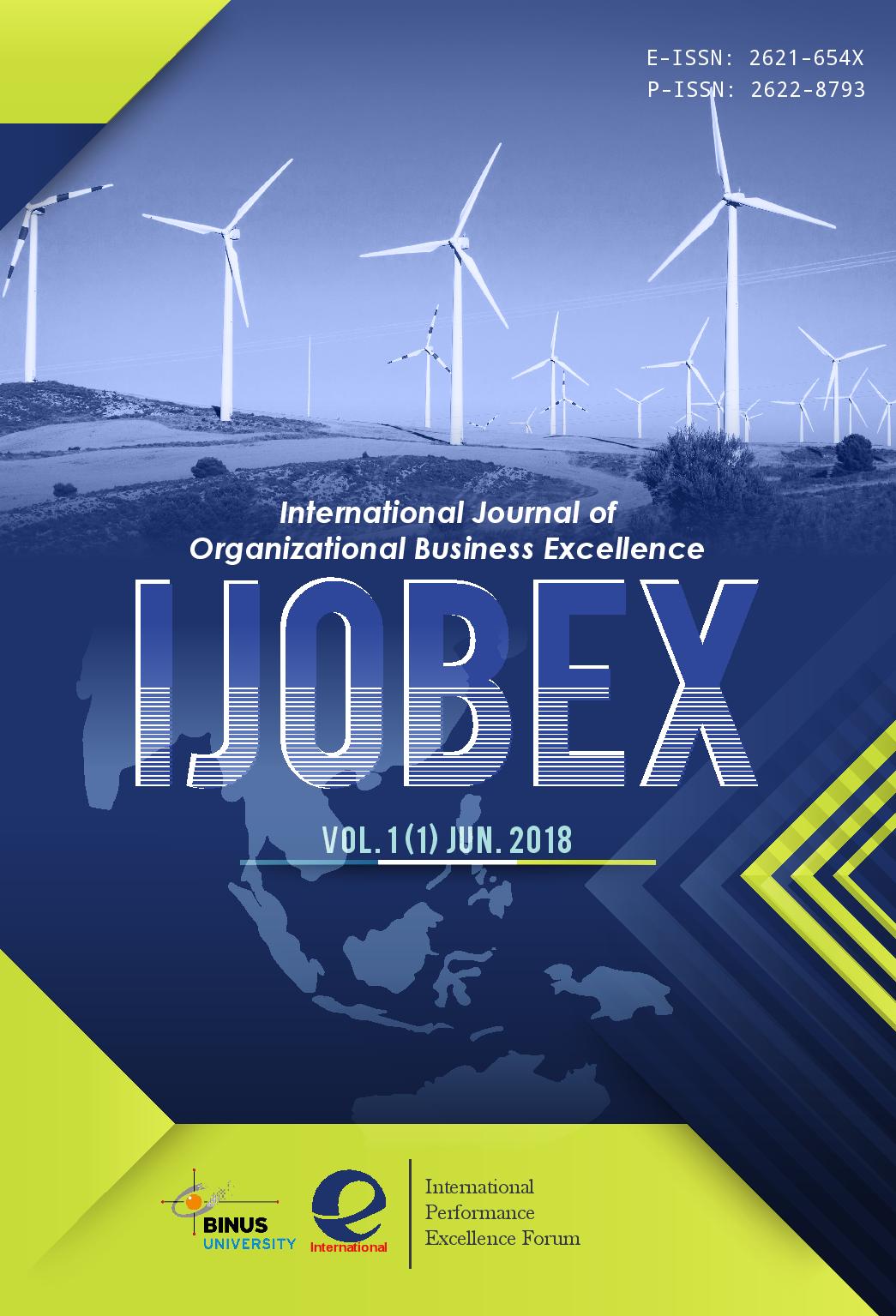Abstract
Companies must have a competitive edge that can only be achieved through productivity, innovation, creativity, and consistently passionate and loyal employees to compete in a similar industry. Appropriate human resource management concepts and techniques should be also applied to ensure excellent job performance, effective leadership, good employee engagement, adversity quotient, and a supportive work environment. The research aimed to analyze the effect of leadership, commitment, and adversity quotient on the performance of employees of PT Mitra Integrasi Informatika. The research used a quantitative method by using questionnaire to collect data. The population is selected from employees in this company. By using Slovin formula, the number of samples needed was 109 respondents. The questionnaire was distributed to the target respondents by using simple random sampling technique. Multiple regression analysis technique was applied to all collected data by using Statistical Product and Service Solutions (SPSS) program version 22. The findings indicate that leadership, commitment, adversity quotient have a positive and significant effect on employee performance.
References
Agusta, Y. N. (2015). Hubungan antara orientasi masa depan dan daya juang terhadap kesiapan kerja pada mahasiswa tingkat akhir Fakultas Ilmu Sosial dan Ilmu Politik di Universitas Mulawarman. Psikoborneo: Jurnal Ilmiah Psikologi, 2(3), 133-140. http://dx.doi.org/10.30872/psikoborneo.v2i3.3653
Alkahtani, A. H. (2016). The influence of leadership styles on organizational commitment: The moderating effect of emotional intelligence. Business and Management Studies, 2(1), 23-34. https://doi.org/10.11114/bms.v2i1.1091
Allen, N. J., & Meyer, J. P. (1991) A three-component conceptualization of organizational commitment. Human Resource Management Review, 1(1), 61-89. https://doi.org/10.1016/1053-4822(91)90011-Z
Buchanan, S. (2014). A tapestry of social work experiences reinforces a commitment to ensuring the safety and welfare of children. Reflections: Narratives of Professional Helping, 39–41.
Chatman, J. A., & O’Reilly, C. A. (2016). Paradigm lost: Reinvigorating the study of organizational culture. Research in Organizational Behavior, 36, 199–224. https://doi.org/10.1016/j.riob.2016.11.004
Chen, J. C., Silverthorne, C., & Hung, J. Y. (2016). Organization communication, job stress, organizational commitment and job performance of accounting professionals in Taiwan and America. Leadership and Organization Development Journal, 27(4), 242-249. https://doi.org/10.1108/01437730610666000
Cravens, K. S., Oliver, E. G., Oishi, S., & Stewart, J. S. (2015). Workplace culture mediates performance appraisal effectiveness and employee outcomes: A study in a retail setting. Journal of Management Accounting Research, 27(2), 1–34. https://doi.org/10.2308/jmar-51169
D’Souza, R. A. (2016). Study of adversity quotient of secondary school students in relation to their school performance and the school climate. [Dissertation, University of Mumbai]
Djastuti, I. (2010). The influence of job characteristics on job satisfaction, organizational commitment and managerial performance. Jurnal Manajemen Bisnis, 3(2), 145-166.
Eneh, S. I. & Awara, N. F. (2017). Strategic human resource management practices and organizational growth: A theoretical perspective. Global Journal of Social Sciences, 15(1). http://dx.doi.org/10.4314/gjss.v15i1.3
Hellriegel, D., & Slocum, J. W. (2010). Organizational Behavior (13th Ed.). New Jersey: Pearson Education, Inc.
Hogan, R., Chammoro-Premuzic, T. & Kasier, R. B. (2013). Employability and career success: Bridging the gap between theory and reality. Journal of Industrial and Organizational Psychology, 6(1), 3-16. https://doi.org/10.1111/iops.12001
Iqbal, N., Anwar, S., & Haider, N. (2015). The effect of leadership style on employee. Arabian Journal of Business and Management Review, 5.
Karimah, R. (2009). Hubungan antara Adversity Quotient dengan prestasi belajar pada siswa SMP 1 Negeri Malang program akselerasi. [Undergraduate Thesis, Universitas Islam Negeri Maulana Malik Ibrahim, Malang].
Khan, M. R., Ziauddin, Farooq, A. J., & Ramay, M. I. (2010). The impacts of organizational commitment on employee job performance. European Journal of Social Sciences, 15(3), 292-298.
Lazaro-Capones, A. R. (2004). Adversity quotient and the performance level of selected middle managers of the different departments of the city of Manila as revealed by the 360-Degree Feedback System. Workshop for Prospective Scholars, International Industrial Relations Association, 5th Asian Regional Congress, Seoul, Korea.
Leman. (2007). Memahami Adversity Quotient. Anima (Indonesian Psychological Journal).
Luthans, F. (2011), Organizational Behavior: An Evidence-Based Approach (12th Ed.). New York; McGraw-Hill.
Nuhu, K. (2010). Effect of leadership styles on employee performance in Kampala District Council. [Master Thesis, Makerere University, Uganda].
Nurdiana, D., Mansur, M., & Abs, M. K. (2016). Pengaruh kepemimpinan, kompensasi, motivasi dan komitmen organisasi terhadap kinerja karyawan (studi kasus pada karyawan PT. Indomarco Prismatama cabang Malang). E – Jurnal Riset Manajemen, 111-126.
Pamuji, K. (2022). Kinerja pegawai Istana Kepresidenan Jakarta berbasis Self-Efficacy. Cilpa: Jurnal Ilmiah Pendidikan Seni Rupa, 7(2), 1–10.
Prabowo, S. S., Jamaluddin, & Syafari, R. (2022). The influence of leadership style and interpersonal communication on the performance of the public relations department in the regional police force South Kalimantan. International Journal of Politic, Public Policy and Environment Issue, 2(2), 61-71. https://doi.org/10.53622/ij3pei.v2i02.129
Robbins, S. P. & Coulter, M. (2016). Management (13th Ed.). England: Pearson.
Song, J. H., & Woo, H. Y. (2015). A study on AQ (Adversity Quotient), job satisfaction and turnover intention according to wprk units of clinical nursing staffs in Korea. Indian Journal of Science and Technology, 8(S8), 74-78. https://dx.doi.org/10.17485/ijst/2015/v8iS8/71503
Sopiatin, P., & Sahrani, S. (2011). Psikologi Belajar dalam Perspektif Islam. Bogor: Ghalia Indonesia.
Stoltz, P. G. (2000). Adversity Quotient: Mengubah Hambatan Menjadi Peluang (translated by T. Hermaya). Jakarta: PT Gramedia Widiasarana Indonesia.
Tian, Y., & Fan, X. (2014). Adversity quotients, environmental variables and career adaptability in student nurses. Journal of Vocational Behavior, 85(3), 251–257. https://doi.org/10.1016/j.jvb.2014.07.006
Tintin, S. (2010). The influence of leadership style on member performance at Sbu Pos Prima Operations Directorate of PT Pos Indonesia (Persero). Journal of Management, 9(2).
Whilhelmus, A. (2011). Work Motivation and Leadership. Semarang: Universitas Diponegoro.
Wijayanti, D. W. (2012). Pengaruh Kepemimpinan dan Motivasi Kerja Terhadap Kinerja Karyawan pada PT Daya Anugerah Semesta Semarang. Semarang: Universitas Negeri Semarang.
Woods, P., & Roberts, A. (2016). Distributed leadership and social justice: Images and meanings from across the school landscape. International Journal of Educational Leadership, 19(2), 138–156. http://dx.doi.org/10.1080/13603124.2015.1034185
Yukl, G. (2015). Kepemimpinan dalam organisasi (7th Ed.) (translated by A. Cahayani). Jakarta: PT. Indeks.
Yunus, D. A. (2013). Pengaruh gaya kepemimpinan, kompensasi dan komitmen organisasi terhadap kinerja karyawan (Studi kasus karyawan sales dan marketing PT. XYZ. [Thesis, Universitas Terbuka, Indonesia].

This work is licensed under a Creative Commons Attribution-NonCommercial-ShareAlike 4.0 International License.

